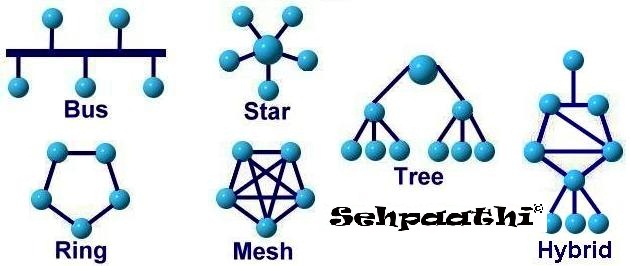NETWORK TOPOLOGIES
 A topology is a generalized geometric configuration of some class of objects that join together. Topologies are the architectural “drawings” that show the overall physical configuration for a given communications system.
A topology is a generalized geometric configuration of some class of objects that join together. Topologies are the architectural “drawings” that show the overall physical configuration for a given communications system.
The different types of topologies are discussed below:
STAR TOPOLOGY:
Features:
- Each node is connected by a point to point link to a central point, called as hubs, concentrators or multipoint repeaters
- These central points can be passive or active
- The hub may have extra features like LEDs that indicate activity and errors on each port, making it even easier to isolate problems
Advantages:
- Easy to install and wire
- One malfunctioning node does not affect the rest of the network
- It can accommodate different wiring
- Easy to add new stations as each station has its own direct cable connection to the hub.
- Stations can be disconnected from the hub one at a time.
Disadvantages:
- If the hub or concentrator fail, nodes attached are disabled
- Depending on where the hubs are located, star networks can acquire more cable length than a linear topology
- More expensive than linear bus topologies
RING TOPOLOGY:
Features:
- A “pure” ring topology is a collection of separate point to point links, arranged to make a ring.
- Data flows only in one direction
- To send a message, a node transmits new bits onto the ring
- If a node receives a message that is not addressed to it, it repeats the message without copying it
Advantages:
- All stations have equal access
- Data packet travel at a greater speed
- Faults tolerance builds into the design
- Degrade nicely under high utilization
Disadvantages:
- Expensive topology
- Failure of one compute may impact others
- It is complex to implement and to extend the network
- Data clashes can also occur if two machines send messages at the same time
MESH TOPOLOGY:
Features:
- Point to point links directly connect every site to every other site
- Usually built over time as new sites are added to the overall network
- Used for MAN or WAN networks
- The number of point to point links increases sharply with the number of locations
Advantages:
- Redundant links between devices
- Good security
- Reliability
- Easy fault identification and isolation
Disadvantages:
- Each node must have an interface for every other device
- Bandwidth is wasted
- Limited amount of I/O ports in a computer
BUS TOPOLOGY:
Features:
- A bus is a single electrical circuit to which all devices in the network are connected
- Cable is terminated at each end
- Wiring is normally done point to point
- A faulty cable will take entire LAN down
- A bus topology is a broadcast network
Advantages:
- Easy to connect a computer or peripheral to a linear bus
- Requires less cable length than a star topology
- Simple and easy to implement and extend
- No central point of failure on a bus because there is no hub
- Relatively easy to install
Disadvantages:
- Entire network shut down if there is a break in the main cable
- Terminators are required at both ends of the backbone cable
- Difficult to identify the problem if the entire network shuts down
- More expensive cabling
- Not very fast
- Higher error probability
- Maintenance cost may be higher in long run
TREE TOPOLOGY:
Features:
- Also known as ‘Hierarchical topology’
- Combination of bus and star topologies
- Very common in large networks
Advantages:
- Point to point wiring for individual segments
- Supported by several hardware and software vendors
Disadvantages:
- More difficult to configure and wire than other topologies
- Overall length of each segment is limited by the type of cabling used
- If the backbone line breaks, the entire segment goes down
























